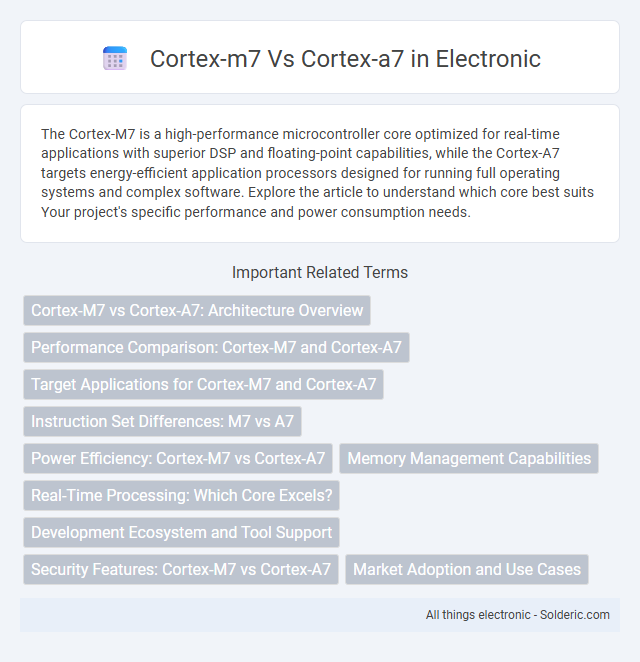The Cortex-M7 is a high-performance microcontroller core optimized for real-time applications with superior DSP and floating-point capabilities, while the Cortex-A7 targets energy-efficient application processors designed for running full operating systems and complex software. Explore the article to understand which core best suits Your project's specific performance and power consumption needs.
Comparison Table
| Feature | Cortex-M7 | Cortex-A7 |
|---|---|---|
| Processor Type | Microcontroller (MCU) | Application Processor (CPU) |
| Architecture | Armv7-M | Armv7-A |
| Performance | Up to 400 MHz, DSP & FPU support | Up to 1.5 GHz, Multi-core (up to 4 cores) |
| Target Market | Embedded systems, real-time applications | Smartphones, tablets, and general computing |
| Memory | Tightly coupled memory (TCM) support | MMU (Memory Management Unit) for virtual memory |
| Power Efficiency | Highly optimized for low power | Moderate power consumption |
| Instruction Set | Thumb-2 32-bit ISA | Full 32-bit ARM ISA with NEON SIMD |
| Use Cases | Industrial control, automotive, IoT devices | Mobile devices, consumer electronics, multimedia |
Cortex-M7 vs Cortex-A7: Architecture Overview
The Cortex-M7 features a 32-bit ARMv7-M architecture optimized for real-time embedded applications with a Harvard architecture providing separate instruction and data buses, enhancing deterministic performance. In contrast, the Cortex-A7 implements the 32-bit ARMv7-A architecture designed for application processing with a unified cache structure and support for virtual memory, enabling complex operating systems. The Cortex-M7 emphasizes low latency and interrupt handling, while the Cortex-A7 prioritizes multitasking and power efficiency in mobile devices.
Performance Comparison: Cortex-M7 and Cortex-A7
The Cortex-M7 delivers high-performance real-time processing with a frequency range up to 600 MHz, optimized for deterministic embedded applications and DSP tasks, while the Cortex-A7 focuses on power-efficient general-purpose computing with clock speeds typically around 1.2 to 1.5 GHz in mobile and low-power devices. Cortex-A7 supports complex operating systems like Linux and features an out-of-order superscalar architecture, enabling higher instruction throughput and multitasking capabilities. In contrast, Cortex-M7 uses a Harvard architecture with tightly-coupled memory for low-latency interrupt handling and predictable performance, making it ideal for real-time control rather than heavy OS workloads.
Target Applications for Cortex-M7 and Cortex-A7
Cortex-M7 cores are ideal for real-time embedded systems such as automotive control, industrial automation, and IoT devices, where deterministic low-latency performance and power efficiency are critical. Cortex-A7 processors target mobile devices, low-cost smartphones, and entry-level consumer electronics, prioritizing energy efficiency and running full operating systems like Linux or Android. Your choice depends on whether your application demands microcontroller-level control or application processor capabilities.
Instruction Set Differences: M7 vs A7
The Cortex-M7 utilizes the ARMv7-M architecture with a Thumb-2 instruction set optimized for deterministic, low-latency real-time processing, whereas the Cortex-A7 employs the ARMv7-A architecture with a full 32-bit ARM and Thumb instruction set designed for complex operating systems and higher performance applications. Unlike the M7's simplified instruction set tailored for embedded control, the A7 supports virtual memory and advanced features like NEON SIMD and hardware virtualization extensions. Your choice between these cores should consider whether your application demands real-time responsiveness with efficiency (M7) or richer software capabilities and multimedia processing (A7).
Power Efficiency: Cortex-M7 vs Cortex-A7
Cortex-M7 processors offer significantly higher power efficiency compared to Cortex-A7 cores due to their microcontroller-class design optimized for low power consumption in real-time applications. The Cortex-M7 operates at lower clock speeds and uses simpler pipeline architectures, resulting in reduced energy usage while maintaining strong computational performance. Your embedded system benefits from extended battery life and minimal thermal output when leveraging the Cortex-M7 for power-sensitive tasks.
Memory Management Capabilities
The Cortex-M7 features a simplified Memory Protection Unit (MPU) designed for real-time control with up to eight memory regions, making it ideal for deterministic embedded applications. In contrast, the Cortex-A7 incorporates a full Memory Management Unit (MMU) that supports virtual memory, enabling advanced operating systems like Linux to manage complex applications efficiently. Understanding your system requirements helps determine whether the Cortex-M7's MPU or the Cortex-A7's MMU better suits your memory management needs.
Real-Time Processing: Which Core Excels?
Cortex-M7 excels in real-time processing with its deterministic, low-latency interrupt handling and tightly coupled memory, making it ideal for time-critical embedded applications. Cortex-A7, while more powerful in general-purpose computing and supporting complex operating systems, lacks the deterministic timing guarantees essential for strict real-time tasks. Therefore, Cortex-M7 provides superior real-time performance due to its optimized architecture and predictable response times.
Development Ecosystem and Tool Support
The Cortex-M7 benefits from a robust development ecosystem tailored for real-time embedded applications, with strong support from ARM's Keil MDK and various RTOS platforms, optimizing low-latency performance. In contrast, the Cortex-A7 is widely supported by extensive Linux-based toolchains and SDKs, making it suitable for application processors requiring higher-level OS environments. Both architectures enjoy comprehensive debugging, profiling tools, and community resources, but their ecosystems target distinctly different use cases--real-time control versus application-rich environments.
Security Features: Cortex-M7 vs Cortex-A7
Cortex-M7 offers enhanced security features like TrustZone for Armv8-M, providing hardware isolation to protect critical code and data, ideal for real-time applications requiring robust security. Cortex-A7 supports TrustZone for Armv7-A, enabling secure and non-secure worlds for application processors but with higher power consumption and overhead. Your choice depends on the balance between processing power and security needs, with Cortex-M7 suited for embedded security and Cortex-A7 for more complex OS-level protection.
Market Adoption and Use Cases
The Cortex-M7 dominates embedded systems in automotive, industrial automation, and IoT due to its high-performance, low-power, and real-time processing capabilities, widely adopted in microcontrollers and safety-critical applications. The Cortex-A7 targets cost-sensitive consumer electronics and mobile devices, offering energy efficiency and sufficient processing power for smartphones, tablets, and entry-level computing, securing extensive market penetration in ARM-based SoCs. Your choice depends on whether your application prioritizes real-time control and energy efficiency or general-purpose computing and multimedia performance.
cortex-m7 vs cortex-a7 Infographic

 solderic.com
solderic.com